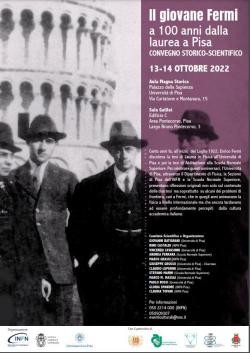
A conference and an exhibition, both inaugurated on Thursday 13 October, celebrate in Pisa the figure of Enrico Fermi, who at the beginning of July 1922, exactly one hundred years ago, discussed his thesis for a degree in Physics at the University of Pisa and immediately afterwards his habilitation thesis at the Scuola Normale Superiore.
To celebrate these anniversaries, the University of Pisa, through the Department of Physics, the Pisa Section of the INFN and the Scuola Normale Superiore, with the patronage of the Municipality of Pisa, are proposing a critical reinterpretation of the content of the two theses and above all of some of the frontier problems, dear to Fermi, that were animating physics at the international level in those years but that were still slow to be perceived in depth by Italian academic culture.
The conference, entitled "Il giovane Fermi a 100 anni dalla laurea" (The young Fermi 100 years after his graduation) will open on the morning of the 13th in the Aula Magna Storica of the University of Pisa, in Sapienza, and will continue on the morning of the 14th in the Aula Galileo Galilei of the INFN and the Department of Physics, in the Pontecorvo Area. During the two days, selected papers will be presented to provide a description of the originality and breadth of the young Fermi's interests during the years of his presence in Pisa and the years immediately following, before he took up his post as a professor in Rome in 1927. After his four years of study in Pisa, from 1918 to 1922, Fermi returned to Rome, his city of origin, and introduced himself to Orso Mario Corbino, then Director of the Institute of Physics in Via Panisperna, who immediately understood the value of the young man. Corbino took an interest in him and sent him to study at Göttingen and Leiden, two prestigious European centres where interest in developments in quantum theory and relativity, which had already been in Fermi's interests since his university years, was very strong. Taking up his professorship at the age of 24, Fermi taught in Florence for two years and in 1926 formulated the 'Fermi Statistic' that brought him international fame. Between 1921 and 1926 Fermi published more than 30 papers on fundamental aspects of relativity, probability, the foundations of statistical mechanics and analytical mechanics, especially in connection with the emerging quantum mechanics. The papers at the conference will be devoted to some of the topics from this period.
The exhibition on "Fermi 100" will be opened on 13 afternoon in the Palazzo della Canonica of the Scuola Normale Superiore and will remain open to all citizens for four weeks. It tells the story of a brilliant young man with a thirst for knowledge since his high school days, and destined to mark the future of physics and not only: just think of how history itself was shattered by Fermi's discoveries in 1934 and their consequences. It was in fact he who, in December 1942 in Chicago, ignited the first nuclear reactor. The material on display in the two rooms, both instruments of the time and documents from the collections of the Museo degli Strumenti di Fisica, the Sistema Bibliotecario dell'Ateneo di Pisa, the Domus Galilaeana, the Scuola Normale and the Museo di Fisica della Sapienza in Rome, describes the study and research activities over a period of about twenty years of a group of young people, led by an equally young Fermi, who were destined to achieve success in many fields of science. In the first room a series of panels describe Fermi's life and work, with a rich photographic documentation, and through monitors one can browse through a rich collection of documents, including Fermi's degree thesis. In the second room are the original instruments present at the Institute of Physics in Fermi's time, all described in detail on other panels that explain their operation. Original material from Fermi's life is also on display here: letters, certificates, documents, the books he studied on. At the end of the tour, testifying to the success of the young man's work (he was only 33 years old...) the original instruments with which, in Rome in 1934, he carried out the experiments that led him to the Nobel Prize four years later, in 1938, are on display.